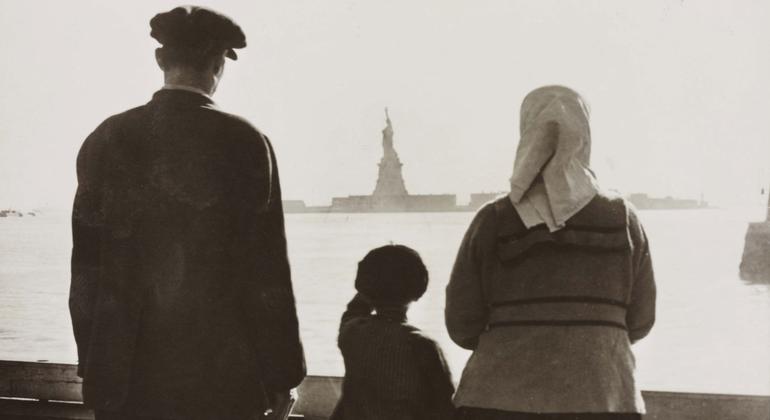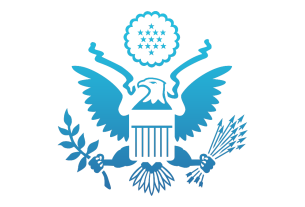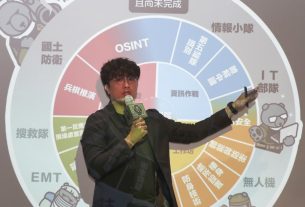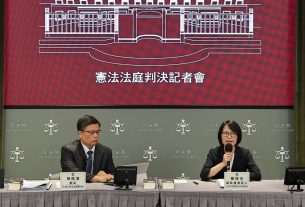[ad_1]
The six-hour-long documentary “The US and the Holocaust”, released in 2022, sheds light on the catastrophic consequences of hate speech and disinformation, and the desperate bid for freedom by millions of Jews fleeing Nazi Germany.
Taste of freedom
What does freedom taste like? Joseph Hilsenrath, a young Jewish boy evacuated to the US during the Second World War, described that sensation in the film.
“The taste of freedom is remarkable,” he said.
Mr. Hilsenrath’s recollection of seeing New York’s Statue of Liberty for the first time in 1942 aboard a ship evacuating him and 49 other children from France, summoned tears to his eyes as well as those of some in the audience on Thursday night, gathered at the UN to watch a 44-minute version of the documentary and meet the filmmakers.
Unveiling racist past
The documentary examines the rise of Adolf Hitler and Nazism in Germany from the late 1930s in the context of global antisemitism and racism alongside the eugenics movement and racist laws in the United States, some repealed as late as the 1960s. Capturing little known facts, it showcases the stories of Joseph, his sister and four other survivors of the Nazi Holocaust, which led to the killing of six million Jewish people, many by specially designed gas chambers in concentration camps like Auschwitz in Oświęcim, Poland.
Unimaginable savagery
“As it was happening to us, we couldn’t believe it,” one survivor said in the film. “The savagery…how would relatives in America possibly imagine?”
Rarely seen images, many from the US Holocaust Memorial Museum, included “trophy” photographs taken by Nazi officers of 15-member firing-squad executions at the edge of deep pits in the ground, which served as mass graves for hundreds of their many thousands of victims. It also featured compelling evidence of resistance, heroism and Jewish refugees’ survival of a Nazi disinformation campaign that led to genocide.
A German policeman checks the identification papers of Jewish people in the Krakow ghetto. Poland. Circa 1941.
‘May history attest for us’
During one deadly uprising, Jewish resistance leaders had buried metal milk cans, filled with notes describing the horrors they faced. A teenager had written a painful request: “may history attest for us.”
The survivors’ stories and interviews with historians amplify a stark warning against a tide of hateful campaigns currently fuelling Holocaust denial rhetoric and a spike in antisemitism.
In the last week alone, a Holocaust memorial statue was vandalized in Sweden, a swastika was painted on a headstone in a cemetery in Australia and a Molotov cocktail was thrown at a synagogue in the United States.
While the documentary noted that the US had hosted more Jewish refugees fleeing the Nazis than any other nation, the country could – and should – have done more to grant freedom to those in desperate need, Mr. Burns said. The film aims at raising awareness, including about the desperation facing refugees, then and now.
Chewing gum and safety
For Mr. Hilsenrath’s sister, Susan Warsinger, the first tastes she remembered upon arriving on New York’s Ellis Island in the 1940s while being processed as a refugee was of gooey soft “Wonder Bread” and a mysterious candy that lasted all day. It was her first taste of bubble gum and genuine safety, following the evacuation from France.
However, the overall taste of that era is bittersweet. Ms. Warsinger was one of around 200,000 Jewish refugees hosted by the United States, which turned away many, many more than it admitted.
More than 100 antisemitic groups were founded across the country, which was cloaked in a depressed economy, segregation, and public wariness of immigrants.
Following the 1938 Kristallnacht pogrom in Nazi Germany, Mr. Burns said a survey in the United States revealed that about 85 per cent of Protestant and Catholic Christian respondents “did not want to let refugees in”.

Immigrants waiting at Ellis Island in October 1912.
Nazis copy US race laws
During this time, Nazi jurists had drafted antisemitic legislation using US segregation and anti-miscegenation laws that targeted people of African descent.
The Nazis’ interracial marriage ban drew heavily on similar laws – enforced since 1691 – which the United States Supreme Court eventually struck down in 1967.
When the US had condemned Germany for its campaign against Jewish people, “the Nazis replied: Mississippi”, said co-director Ken Burns in a question-and-answer segment following the screening, referring to one southern state where racist laws were upheld well into the twentieth century.
One question about what the filmmakers learned came from author Ann Weiss, who prefaced a query by saying “I have virtually no family because they are in those pits.”
Lessons rarely taught
Answering, co-director Lynn Novick said she had been surprised to learn more about a dark side of history rarely taught in schools.
“We won’t work on a more important film in our professional lives,” Mr. Burns said. When production started, the subject had a distance from current events, he explained in an interview with UN Video.
“What made us very uncomfortable was the extent to which the events in the film were beginning to be mirrored by events in the United States and the world,” he said, expressing hope that the legacy of the survivors’ stories and their history lessons will reach a broad audience.
In that vein, the Public Broadcasting Service (PBS) in the US now offers the film and related teaching materials, said Ms. Novick, stressing that teachers are “on the front lines of telling the truth about history”.
Some audience members also voiced surprise at the lessons they learned from the film.
“I was not taught any of that,” said US-raised UN Global Communications chief, Melissa Fleming, who moderated the discussion.

Film director Ken Burns discusses his film at the UN.
New UN code of conduct
Prior to the screening, a high-level side event on globalizing efforts to combat antisemitism drew attention to learning from the past and using bold initiatives to tackle today’s rising antisemitism.
In the works is a new code of conduct, said Ms. Fleming. UN social media campaigns using such hashtags as #NoToHate and #ProtectTheFacts are gaining traction, and a joint publication with the UN Educational, Scientific and Cultural Organization (UNESCO) – “History under attack: Holocaust denial and distortion on social media” – will also feature a related panel discussion with civil society.
The UN also created programmes on the Holocaust and the Genocide against the Tutsi in Rwanda along with its Strategy and Plan of Action on Hate Speech. In 2022, the UN General Assembly adopted a resolution to combat Holocaust denial.
Antisemitism is a ‘global pandemic’
At the side event, Ambassador Gilad Erdan of Israel, himself a grandson of Holocaust victims, commended ongoing efforts, but said “the UN must do more.”
“Words are not enough,” he said. “Hateful words always mutate into violent actions. Antisemitism is a global pandemic. No Jew should ever live in terror.”
Silence ‘is not an option’
Efforts must include a pushback against Holocaust denial, with consequences for those engaged in antisemitism, said Doug Emhoff, the Second Gentleman of the United States, speaking at the event.
“Silence is not an option,” he said. “We must all speak out against antisemitism and build coalitions to tackle this tide of hate. Any threat to one community is a threat to all communities. We must instil knowledge to fight antisemitism.”
Ambassador Linda Thomas-Greenfield of the United States, which co-hosted the event, warned that hate is fomenting, both online and in person.
“All around the world, antisemitism is pervasive and it’s growing,” she said. “We need to stand up to this threat and stand up for Jewish people everywhere.”

Shmiel and his family in Bolechow, Poland, 1934.
Halting ‘digital antisemitism’
Fighting “digital antisemitism” is essential, Ms. Fleming said, highlighting such alarming internet algorithms as “6mwe” – “six million weren’t enough” – referring to the number of Jews killed by Nazis.
A 2022 UN report showed that antisemitism is rampant on some platforms, with 50 per cent of posts on the Telegram social media platform relating to Holocaust denial, she cautioned. To combat this trend, the UN partners with Facebook and TikTok to publish accurate information.
‘Rabbit holes of hate’
“The hate is circulating far and wide,” the UN communications chief said, adding that nefarious algorithms are leading people down “rabbit holes of hate” and disinformation, including movements denying the Holocaust ever happened.
“We are appealing to the tech companies to stop this because the dangers of distortion and denial are too much,” she said, warning that lies about a “white genocide” have begun to spread, fuelling violence and gathering followers online.
“We used to laugh at the rise of Q-Anon, but we’ve seen it enter the rest of the world thanks to social media,” she said, referring to the US-based movement fuelling conspiracy theories and other groups that have been “repackaged for the internet age”.
“We’re in a moment when we need a wake-up call,” she said. “Holocaust denial and distortion are attacks on historic truth.”
[ad_2]
Source link



